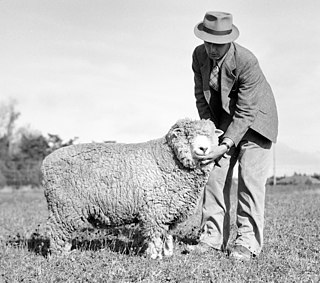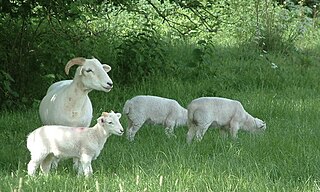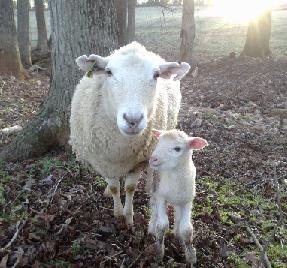Related Research Articles

The Merino is one of the most historically relevant and economically influential breeds of sheep, much prized for its wool. The origins of the breed are the subject of debate, with alternatives of it originating in flocks transferred from Morocco as early as the 12th century, originating and being improved in Extremadura in southwestern Spain, in the 12th and 13th centuries or from the selective crossbreeding of Spanish ewes with imported rams at several different periods. It was instrumental in the economic development of 15th and 16th century Spain, which initially held a monopoly on the trade in its wool. Since the end of the 18th century, the breed was further refined in New Zealand and Australia, giving rise to the modern Merino.

The Coopworth breed of sheep was developed by a team of scientists at Lincoln College in Canterbury, New Zealand, to increase lambing percentages of Romney ewes when mated with Border Leicester rams. The breed makes up the second largest flock in New Zealand. It is also bred in Australia, parts of Europe, and the United States. The Coopworth is used for both meat and wool. An average fleece weighs 5 kg, with a fibre diameter of about 30 to 35 microns being in the coarser range of wools with a staple length of between 125 and 200 mm. The live weight of an adult is about 55 kg.

The Drysdale breed of sheep originated in New Zealand and is raised primarily for wool. Dr. Francis Dry in 1931 noticed a genetic freak, a Romney ram with a high percentage of very coarse wool. Crossing two Romneys and Cheviots resulted in a sheep with a lot of coarse fleece which is about 6 kg (13 lb) with a 40 microns fibre diameter and a staple of 200 to 300 mm. The coarse wool gene causes both male and female Drysdales to be horned. The male's horn resembles a Wiltshire ram's horn whereas the ewe's horns are very small - usually only 8 to 9 cm in length. Live weight is 60-70 kg.
Polwarth is a breed of sheep that was developed in Victoria (Australia) during 1880. They were of one-quarter Lincoln and three-quarters Merino bloodlines. They are large, predominantly polled sheep with long, soft, quite fine wool and produce good meat carcasses. They were developed in an attempt to extend the grazing territory of sheep because the Merino was found lacking in hardiness in this respect. A dual-purpose breed with a major emphasis on wool production. Richard Dennis, of Tarndwarncoort in south west Victoria, bred the Polwarth, first known as Dennis Comebacks. Descendants of Richards Dennis continue to grow Polwarth wool at Tarndwarncoort, maintaining the original bloodlines in a flock referred to as the "Blue Dots".

The Border Leicester is a British breed of sheep. It is a polled, long-wool sheep and is considered a dual-purpose breed as it is reared both for meat and for wool. The sheep are large but docile. They have been exported to other sheep-producing regions, including Australia and the United States.

The Jacob is a British breed of domestic sheep. It combines two characteristics unusual in sheep: it is piebald—dark-coloured with areas of white wool—and it is often polycerate or multi-horned. It most commonly has four horns. The origin of the breed is not known; broken-coloured polycerate sheep were present in England by the middle of the seventeenth century, and were widespread a century later. A breed society was formed in 1969, and a flock book was published from 1972.

The Texel is a breed of domestic sheep originally from the island of Texel in the Netherlands. A heavily muscled sheep, it produces a lean meat carcass and will pass on this quality to crossbred progeny. The wool is around 32 micrometres and is mostly used for hosiery yarns and knitting wools. It is presently a popular lean meat sheep across Europe, as well as Australia, New Zealand and the United States.

Corriedale sheep are a dual purpose breed, meaning they are used both in the production of wool and meat. The Corriedale is the oldest of all the crossbred breeds, a Merino-Lincoln cross developed almost simultaneously in Australia and New Zealand and first brought to the United States in 1914. The Corriedale is internationally farmed, in Australia, New Zealand, the United States of America, Southern Brazil, Uruguay and Patagonia. Corriedales are one of the most popular sheep breeds in Uruguay. On the Falkland Islands, Polwarth and Corriedale form the main sheep breeds.

The Poll Merino is a subtype of the Australian Merino breed of domestic sheep, without horns, that was developed in Australia.

The Shetland is a small, wool-producing breed of sheep originating in the Shetland Isles, Scotland but is now also kept in many other parts of the world. It is part of the Northern European short-tailed sheep group, and it is closely related to the extinct Scottish Dunface. Shetlands are classified as a landrace or "unimproved" breed. This breed is kept for its very fine wool, for meat, and for conservation grazing.

The Wiltshire Horn is a breed of domestic sheep originally from Wiltshire in southern England raised for meat. The breed is unusual among native British breeds, for it has the unusual feature of moulting its short wool and hair coat naturally in spring, alleviating the need for shearing. They are good mothers and have high fertility. The fact that they do not require shearing or crutching and do not suffer readily from flystrike is making them increasingly attractive to the commercial sheep sector, particularly as even pure-bred lambs can reach slaughter weight in as little as 16 weeks.

The St Croix is a breed of domestic sheep native to the U.S. Virgin Islands and named for the island of Saint Croix. They are often also called Virgin Island White because those that were imported into North America were selected for white coloration. On the Island of St. Croix, they come in shades of brown, white and black.

The Columbia is one of the first breeds of sheep developed in the United States. The product of USDA and university research, it was intended to be an improved breed adapted for the Western ranges of the country.

The Poll Dorset, a short-wool, meat-producing sheep, was developed in Australia between 1937 and 1954 with the aim of breeding a true Dorset type sheep without horns. The poll gene was introduced into Dorset Horn flocks from two other polled breeds and following a strict back-mating programme achieved close to 100% of Dorset Horn blood. Its main distinguishing features are its hornless appearance, long, lean square body set on short legs, pink skin and 'spongy' short-stapled wool. The Poll Dorset produces a fleece of white, dense downs type wool of 30 microns fibre diameter and it has a white wool-free face. The breed was developed at a property called Valmore in Whitemore, Tasmania, a noted centre for pedigree livestock stud farms. The Poll Dorset resulted from the introduction of Corriedale and Ryeland blood into the Dorset Horn.

The Charollais is a breed of domestic sheep originating in east central France, in the same region in which Charolais cattle originated, Charolles and Saône-et-Loire. It is known for ease of lambing and is used as a terminal sire to increase muscling and growth rate of the lambs. It has been exported internationally, and is commonly used in the United Kingdom as a sire to produce market lambs from pure-bred ewes and mules.

The Basco-béarnaise is a domesticated breed of sheep originating in the Basque country. The breed was developed from Basque and Béarnaise sheep during the 1960s to be a single-purpose milk breed.
Altay is a breed of domesticated sheep originating in the dry, cold mountain basins of China. This breed belongs to the fat-rumped carpet wool type of sheep and the Kazakh group. Although the Altay grows wool, it is raised primarily for the meat.
The Comeback is a type of domestic sheep originating in Australia. This type of sheep results from crossbreds produced by British Longwool sheep and Merinos being mated back to Merinos. This cross is made to achieve a finer, better style of wool. Comeback style wool is also produced by Bond, Cormo and Polwarth sheep and they may prove easier to breed than Comebacks. The Comeback sheep are raised for meat and their fine wool.

The Meatmaster is a breed of domestic sheep native to South Africa. Bred in the early 1990s from various hair sheep breeds, the Meatmaster was created with the goal of improving the meat characteristics of African fat-tailed sheep breeds. The fat-tailed sheep had various advantageous characteristics such as hardiness and suitability for desert life, but was slow to mature, had a poor distribution of fat and lacked the muscling of the hind quarters of European breeds. The composite breed increased the amount of muscle and had a better distribution of fat but retained the hair coat and other desirable traits such as resistance to tick-borne diseases and a good flocking instinct.

The Polled Dorset is an American breed of domestic sheep. It is a polled (hornless) variant of the British Dorset Horn. It was developed at the North Carolina State University Small Ruminant Unit in the 1950s after a genetic mutation led to the birth of a polled ram. After some years of breeding work, a true-breeding polled strain was established.
References
- 1 2 "Elliottdale". Oklahoma State University, Dept. of Animal Science. Archived from the original on 2010-06-05. Retrieved 2010-06-23.
- ↑ Preparation of Australian Wool Clips, Code of Practice 2010-2012, Australian Wool Exchange (AWEX), 2010
- ↑ "Elliotdale/Australia". Domestic Animal Diversity Information System (DADIS), Food and Agriculture Organization of the United Nations. Archived from the original on October 21, 2012. Retrieved 2010-06-23.
4. Conversations with Carl Terrey, A member of the Elliott Research Station team and Elliotdale breeder from 1986. Tasmania